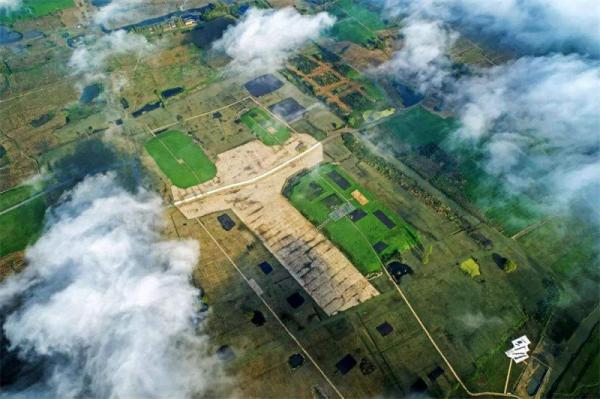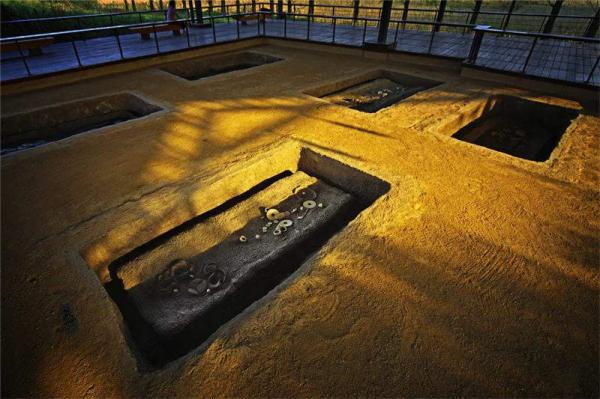Is Chinese civilization 5000 year old? Is there any archaeological evidence found?
The criterion for the emergence of civilization is the establishment of nations and city-states. According to historical records, China has a history of 4100 years from the beginning of the Xia Dynasty, which still needs more supporting archaeological evidence. In the past, the internationally recognized Chinese civilization started from Shang Dynasty based on the findings of Yin Ruins 3,600 years ago. During the archaeological excavation of Liangzhu ruins in recent years, the mystery of a new civilization site was disclosed from underground.
Dating from 5300 to 4300 years ago, Ruins of Liangzhu City is mainly distributed in northern Zhejiang, southern Jiangsu and Shanghai areas in the Taihu Lake basin of the Yangtze River Delta, but its influence range is much larger than we expect. Advanced rice farming technique and unparalleled jade system are the typical features of Liangzhu culture.
With the continuous archaeological excavations of the ruins, religious altars, tombs, and large dams were found in recent years, the international academic circles have gradually reached a consensus that Liangzhu site has surpassed the stage of tribes and tribal alliances and entered into the stage of a regional urban civilization, which means Chinese civilization has been proved to be 5000 years old.

Why can we consider Liangzhu site as the early form of a state?
1. An intact and multifunctional City
The ancient city of Liangzhu has been in use for more than 1,000 years since 5,300 years ago. With an urban area of 8 million square meters, it became the largest city in the world at that time. The ancient city of Liangzhu and more than 100 archaeological sites such as Fanshan, Yaoshan, Mojiaoshan, Tangshan, Wenjiashan and Bianjiashan previously discovered have formed a full picture of Liangzhu ruins 5,000 years ago.
According to the archaeological discoveries, the layout of Liangzhu Ancient City is very similar to that of Beijing city in Ming and Qing Dynasty, which consists of palace area, inner city and outer city. The palaces were built on the artificial 15-meter-high platform with an area of about 300,000 square meters in total. The earthwork volume is comparable to that of the Great Pyramid of ancient Egypt. About 15 meters long wooden components were found in the palace area, which shows the grandeur of the palace and capability of building such a huge project. Without a highly developed and highly organized civilization, it was difficult to fulfill the task relying on immense manpower and adequate food supply.

The outside of the palace is the inner city with an area of 3 square kilometers, which is 4 times bigger than the Forbidden City of Beijing. This is a very huge project for Chinese ancestors, since the inner city was built on the swampy land, the ancient people have to lay the stones obtained from the distant mountains on the ground, and then piled yellow clay on the stones. There was a circular city wall on the periphery of the inner city, with the wall width ranging from 20 meters to 150 meters. Now there are about 4 meters left, and the circumference of the city wall is 6 kilometers long.
In 2010, the outer city was discovered outside the inner city, covering an area of 8 square kilometers. Such an enormous human habitation was never found before among all the Neolithic sites in China.
Now we can clearly see the layout of the ancient city of Liangzhu. At that time, the most powerful people lived in the palace on the high platform, and the average people including artisans lived on the periphery by the river. The width of the river outside the inner city was about 50 meters, but people often dumped rubbish and disposed of waste in it. In the end, the narrowest part of the river turned only 10 to 20 meters wide. The pottery, wood, bone and jade pieces found in it reveal the living conditions at that time. The outer city is similar to the inner city, but the water surface outside the city wall is much bigger, which provides a natural defensive barrier.
The reasons that the ancient people built their city here might be as below:
A. the plain and swampy area is good for rice farming and fishing to have enough food supply;
B. neighboring mountains can provide minerals, timber and animal meat & leather.
C. waterway transport is convenient;
D. the location is far from other strong tribes, with less threat of war.
2. the largest water conservancy project in the world 5000 years ago
More than ten kilometers northwest of the ancient city of Liangzhu, archaeologists recently discovered 11 dams built 5,000 years ago. The finding of the water project has advanced China's water conservancy history by more than 2,000 years. Researchers believe that it is also the earliest and largest water conservancy project in the world so far.
The project was designed to control the floods from the northwestern mountains after the torrential rain in the area. Without it, the floods might threaten the safety of the ancient city. Therefore, before the construction of the city site, about 5100 to 5000 years ago, the ancient people first built a large dam near the foot of the mountain, which was 50 meters to 70 meters wide and about 5 kilometers long.
From 2009 to 2015, archaeologists discovered a total of 11 dams, which formed a reservoir area of about 13 square kilometers, and led water to the edge of the ancient city of Liangzhu through a 5-kilometer-long dyke.
According to the calculation of experts, the construction earthwork including the inner city, the outer city and the dam totals about 11 million cubic meters, while the current 632-meter-high Shanghai Tower, the tallest building in China, has only 600 thousand cubic meters of earthwork, only 1/10 of the ancient city of Liangzhu. The implementation of such a large-scale project requires a very strong planning, organization, construction and supply system. Therefore, both international and Chinese archaeologists agree that the Liangzhu Ruins has reached a stage of early urban civilization.
So how did the Liangzhu people make the huge project? It was found that they had adopted a method of wrapping mud with grass, putting the mud into straw bales of thirty or forty centimeters in diameter, and then tying them up with reeds, and using this kind of grass-wrapped mud to build earth platforms and dams. During the construction, the enormous crowd tactics had to be adopted. Some people weaved straw bales in one place, which would be transported to the mud filling site. After earth packing and bundling, piles of mud bales were transported to the construction site by boats/rafts. Then the construction workers put them on the high platform or dam.
Archaeologists also found that these projects were carried out continuously. If the project was interrupted for a few months or a year, the difference of wall forming would be seen during the archaeological excavation, it is believed that all the parts were completed at one time. To have so many people to do one thing at a certain time, they didn’t need to work on farming or handicrafts, a highly organized society was required to have good logistic support. Without large food production and supply, an enormous project of this scale couldn’t be done 5000 years ago.
3. Rice farming Culture: one granary with a storage capacity of 20 metric tons of rice
What laid the foundation of the thousand-year-long prosperity of Liangzhu Ancient City? The answer from the experts was the advanced rice farming. Farmers worked hard in the plains and swamps around the ancient city, supporting the city's aristocrats, craftsmen and builders of large-scale projects.
At the Maoshan site near the ancient city, archaeologists discovered a paddy field with an area of 5.3 hectares. We can see the ridges in the field paved with red soil. The length of each ridge was about 100 meters, and the width between the two ridges was about 20 meters. Each block of paddy field is about 2,000 square meters. Stone plows and ox footprints were also found here, so experts speculate that ox-drawn plows appeared in the farming work of Liangzhu Culture. The stone sickles and plows at that time had basically the same working style as those used in later days (except the material), which shows that the rice farming at the moment was relatively mature.
In 2010, on the east slope of the palace area of Mojiao Mountain, archaeologists discovered an ash pit, which was filled with burned rice, weighing 10 to 15 tons. Based on the results of Isotope analysis, these rice remains did not come from the same place, so it was inferred that this was a granary for the rice storage. In 2017, when drilling down the high platform in the south of the palace area, it was found that there was also burned rice underneath, covering an area of about 5,000 square meters with a depth of 60 centimeters. It is estimated that the burned rice here weighs about 20 metric tons, and there are ashes and remains of straw, wood and rope in it, therefore, it should be another granary.
According to the analysis of archaeologists, the large stock of rice from different regions means that ancient people in a wide area had to pay tribute to the ruling class. Possibly there was a ruler or king living in the ancient city, who was responsible for his tribal people in and around the city of Liangzhu.
4. Jade Culture: a spiritual totem and a symbol of power
The jade ware found in Liangzhu city is considered as a peak of the developmental history of jade ware during the prehistoric period. They are the symbol of power in Liangzhu culture, and they are also the media that communicate between heaven and earth, gods and human. It can be said that the jade culture helped to construct the authority/power system and spiritual world of Liangzhu people.
A large number of exquisite jade articles have been unearthed from the tombs of the nobles in Fanshan and Yaoshan at the Liangzhu site. Among them, the jade cong with the basic concept of "round sky and square earth" is the most representative type of articles in Liangzhu culture. It is an artifact for people to communicate with the gods of heaven and earth; the axe-shaped jade Yue is an important symbol of kingship; thousands of jade bi was excavated in elite burial sites, which in later generations evolved into an important ritual instrument for "respecting the sky with green bi".
On the surface of jade artifacts unearthed in aristocrats’ tombs, there are many patterns of the faces of gods, humans and animals. Among them, the symbol of a person wearing a feather crest riding on a mythical beast with round eyes and sharp tusks is the most respected spiritual totem of the Liangzhu people. This image was widely discovered in the influence area of Liangzhu culture, indicating that it was a common totem respected at that time. The high consistency of this belief showed that Liangzhu culture had a strong assimilation capability. Because such artifacts are only found in the tombs of the upper class, this indicates that the elite held the power of religious ceremonies. The some patterns were kind of micro-engraved, and how the ancient people achieved it still remains a mystery today.
Today, when we appreciate these jades, we can’t just stop at the craftsmanship, because they mark the difference of people’s identities, signifying that power is held in a certain group of society. This also means there was a common belief in a wide area around Liangzhu city. Many experts agreed that there was a strict social hierarchy and a common spiritual world in Liangzhu society.
Unfortunately, about 4,100 years ago, the Liangzhu Culture suddenly disappeared. Experts believe that the most likely cause was the flood. Archaeologists found that the El Niño phenomenon affected the northern hemisphere at that time, so there were legends of a great flood in many countries, and the 1,000-square-kilometer basin around Hangzhou was submerged in floods for one or two thousand years. The Great Flood destroyed the Liangzhu culture, but it also allowed the Liangzhu ruins to be completely preserved, making today's people to understand this glorious prehistoric civilization through archaeology.
To sum up, we’d like to cite the narrative on the official site of WHC: the archaeological ruins of Liangzhu (about 3,300-2,300 BCE) reveal an early regional state with a unified belief system based on rice cultivation in Late Neolithic China. Therefore, this can be a convincing evidence of the origin of Chinese civilization. It is also believed that the new archaeological discoveries will give us more and more surprises regarding the sources of China. The Ruins of Liangzhu city constitute an important part of early Chinese civilization.


